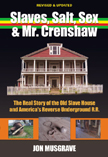 |
In 2013 Jimmy Zuber holds one of the rifles his
uncle Earl Shelton purchased for him and his
cousins should they ever get the chance
to kill their family nemesis Charlie Harris |
|
My
Inside the Shelton Gang co-author
Ruthie Shelton texted me the news this morning. James Shelton Zuber, better known simply as Jimmy Zuber, nephew of the Shelton Brothers, died last week in Florida on the 19th. He was 84, and probably the last surviving member of the notorious Shelton Gang. He was the youngest of the three nephews involved in their uncles' gang.
Jimmy was 17 and still in high school in 1947 when gunmen ambushed his uncle Carl Shelton in the Pond Creek Bottoms in Wayne County. His cousin, and Ruthie's father, "Little Carl" Shelton, collected him from school to tell him the news.
While he was never a gunman for the gang, he did serve as a bagman for a bit. After Carl's death his brother Earl took over the duties, but when he moved back to Wayne County to focus on farming, Jimmy got the job. As he told Ruthie and me a few years ago, one of those deliveries was an envelope full of cash to the governor himself in the Illinois Statehouse.
Most interestingly it wasn't to Dwight Green who historians already knew had connections to the gambling rackets, but his successor and later presidential candidate Adlai Stevenson. While remembered as a reformer, Stevenson didn't start to shake up Springfield until towards the end of his second year in office, about the same time the
Kefauver Hearings brought their investigators to Illinois.
Jimmy was the son of the Shelton's sister Lulu. Following his parents' divorce the Sheltons later kidnapped and brought him back to Illinois to be raised. He wouldn't see his father again until after he reached adulthood. Although the three Shelton brothers known as the gang had step-children at different times, it would be their sister's son and brother Dalta's two boys, "Little Earl" and "Little Carl" that they groomed to be successors.
Zuber never indicated his involvement in any of the gang's violent crimes, as those opportunities were quickly diminishing with Bernie's assassination in 1948, Roy's in 1950, and the multiple attempts on the lives of his uncle Earl, his mother and stepfather, as well as his cousin "Little Earl" in the late 1940s.
Once in Fairfield he had his own close call with the family nemesis Charlie Harris who declined to shoot the then still teenager. Later his uncle Earl gave all three nephews rifles with the instruction to kill Harris if they ever had the chance. Ruthie's father had long since parted with his, but Jimmy proudly showed us his which he still had.
After the extended Shelton clan fled Fairfield for Florida (but not after sneaking his mother Lulu who was recovering from being machine-gunned by Harris out a hospital window), Jimmy went into construction in Florida. He and his wife raised a family and left the Illinois past behind them mostly.
In the late 1990s he became a source of family information and photographs for Taylor Pensoneau when he researched the Sheltons for his book,
Brothers Notorious. Years later I approached Taylor at a book signing for his Charlie Harris book, "Dapper and Deadly," with the intention of getting Jimmy's contact information. Instead he told me about another Shelton family member doing research for a book. That person turned out to be Ruthie.
I know Ruthie met with or talked with Jimmy by phone numerous times as she researched her family history. In the summer of 2012, I had a chance to meet with him at his home as well. He was a delightful subject to interview with his wife surprising us with additional photo albums and he really exciting Ruthie when he mentioned the rifles. (The only frustrating moment that day was him not being able to find the key to the gun cabinet. Ruthie had to wait a few months and another trip before she could hold it.)
His
obituary noted that he was cremated. He was a good guy, and will be missed.








